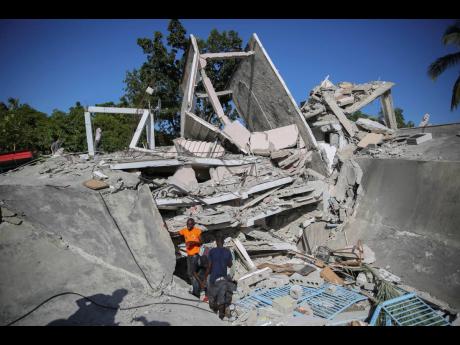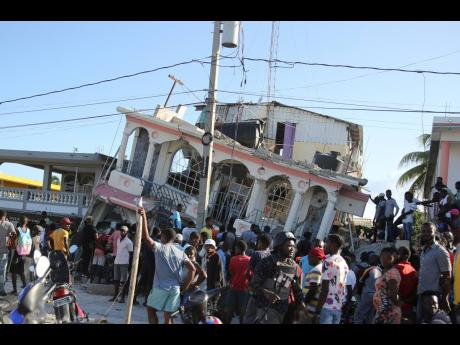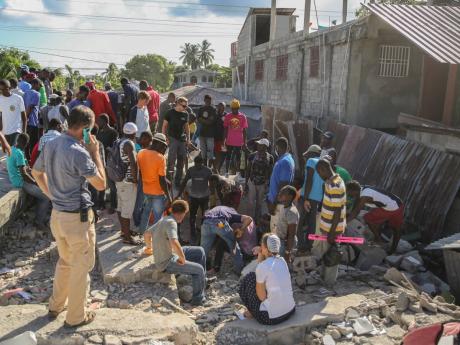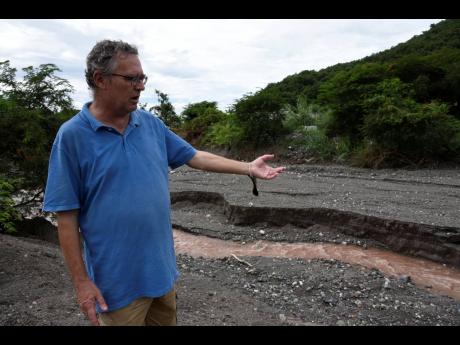Earthquake warning!
Expert urges Jamaicans to be on alert following yesterday’s deadly quake
Jamaica should be on alert for the possibility of a major earthquake following yesterday morning’s 7.2 magnitude earthquake that struck Haiti, killing over 300 persons, injuring several others and causing massive damage.
“Yes, we are at risk of a major earthquake because this quake, just like the one in Haiti 11 years ago, is on the same fault line that runs along the south-west of Haiti and comes into Jamaica,” seismologist and research director at the Earthquake Unit, Professor Simon Mitchell, told The Sunday Gleaner.
He cautioned, however, that, “It doesn’t mean we are going to get one immediately, but we should be very much aware that we have not had a large earthquake here along that fault line since 1907.”
At approximately 7:30 yesterday morning, several Caribbean countries were hit by the strong quake that had an epicentre of about 125 kilometres (78 miles) west of the capital of Port-au-Prince, the United States Geological Survey said. Among the countries that reported feeling the 7.2 magnitude earthquake were Jamaica, Haiti, The Bahamas, Dominican Republic, Puerto Rico, Turks and Caicos, Cuba and United States Minor Outlying Islands.
In Jamaica, persons across several parishes reported experiencing it, including in Kingston, St Andrew, St Catherine, St Ann, St Mary and St James. Many took to social media to express their fright.
Medical doctor at the Kingston Public Hospital, Shane Murray, explained that he was at home in Portmore when he was startled by the shaking, which he described as a dreamlike experience.
“I just woke and I felt the bed moving. The first question I asked was whether this was real, so I reached out to my wife who also said she felt the same. I checked immediately to see online and then I saw that the epicentre was in Haiti,” he said.
PRESSURE ON THE FAULT LINE
Professor Mitchell said that large earthquakes such as this can put pressure on other parts of the fault line. Areas of Jamaica that are particularly vulnerable include eastern and southern parishes such as St Thomas, St Andrew and Kingston, he noted.
“If a similar earthquake was to take place in Kingston, we would probably see a lot of houses collapse; a lot of people unfortunately losing lives; the infrastructure will be damaged. We might lose electricity and we might lose water,” the professor stated.
Additionally, structures along downtown Kingston and the Palisadoes are also at risk of sinking due to liquefaction. Mitchell pointed out that it was impossible to determine the extent of potential damage to multistorey buildings as these structures have not been tested to determine if they can withstand a major earthquake.
“The only recent earthquake we had in Kingston was really in 1993 which was only 5.2, so that is not very large. Remember, each magnitude is 10 times higher so the one that just happened in Haiti has 100 times more energy than the one that happened in Kingston in 1993,” Mitchell explained.
Yesterday, there were scenes of devastation in towns and communities across southern Haiti from the massive 7.2 magnitude earthquake. Images of collapsed buildings and rubble stirred painful memories of the catastrophic January 12, 2010, 7.0 magnitude earthquake that levelled large swathes of Haiti and left some 300,000 dead. Approximately 1.5 million people were displaced, with damage estimated to be upwards of US$8.5 billion.
‘IT IS A CATASTROPHE’
President of the Jamaica Haiti Society, Myrtha Désulmé, was also awakened by the early morning quake.
“The earthquake woke me up because I live in a high rise building and the entire building was shaking. My bed was shaking and the paintings on the wall were shaking, so that was very scary,” Désulmé told The Sunday Gleaner.
She lamented the series of unfortunate events that continue to befall her nation.
While the earthquake has been a surreal experience for the Jamaicans that felt it, the situation in Haiti can be described as a nightmare, with over 300 dead and counting. Among the casualties is former senator and the mayor of Les Cayes, Jean Gabriel Fortuné, who died when the hotel he was staying at collapsed.
Dr Frantz Large, head of the health commission for the Lions Club of Haiti, described scenes of utter ruin across the south-western end of the French-speaking nation. Towns such as Baraderes near the epicentre of the quake are completely unrecognisable due to the scale of destruction, he said.
“All the houses of Baraderes are old and the majority of the houses have been destroyed. It is a catastrophe,” he told The Sunday Gleaner yesterday.
He said prisoners have also escaped from the local jail in Jacmel, which has further complicated the situation in Haiti, as lawlessness has gripped areas of the country, with gangs making it impossible to access communities most impacted by the earthquake.
“The hospital of Les Cayes has collapsed. Some of the employees jumped from the windows to save their lives. Many suffered fractures but there is no place to treat them because the major hospital was destroyed,” Dr Large said.





